EXPLORING THE LATIN QUARTER, THE OLDEST ARRONDISSEMENT IN PARIS – PART 1
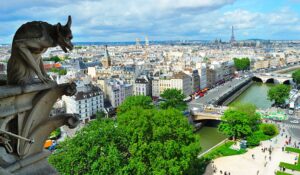
A city as ancient and as large as Paris has an almost overwhelming number of sights to take in. Fortunately, one advantage that Paris has, is that so many of its attractions are within the Périphérique, or ring-road, that defines the arrondissements, or districts, from the areas outside that. As well, Paris has a wonderful, and very accessible, public transport system that makes exploring the city practical and efficient. If you had to nominate one arrondissement that has a concentration, and indeed a richness, of treasures, it would surely be the 5th arrondissement, a large part of which is the Latin Quarter. It has long been one of our favourite areas of Paris, and we are still exploring its many attractions as they evolve along with the city itself.
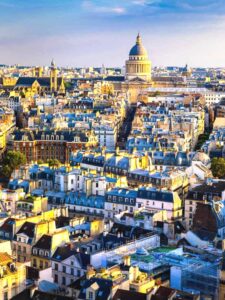
In the area we now know as the 5th arrondissement in Paris, the Latin Quarter has been inhabited for over 2,000 years, with some streets pre-dating the Romans. The area takes its name from the Latin language that was taught and spoken at the Sorbonne University, and its cobblestone streets remind us of what the medieval city of Paris looked like when those early scholars roamed the streets. Today, the Latin Quarter retains much of its ancient feel, as it was largely spared the sweeping changes and renovations of Baron Haussmann.
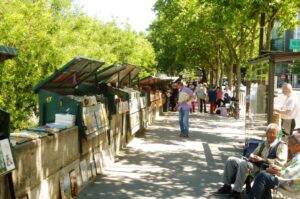
A good place to start exploring the Latin Quarter is right down by the river. Spend a few moments taking in the massive restoration work being carried out on Notre Dame cathedral, which, at least from the outside, is starting to look like how it was before the catastrophic fire of April 2019. It is on schedule to re-open on 08 December 2024, which seemed like an impossibility even a year or so ago. The roadway along the Seine, lined with bouquinistes’ stalls on the footpath, always has crowds gathered watching the activity of the construction workers, who seem like so many ants, and the huge cranes manoeuvring materials across the height of the cathedral. One of the best spots to look at the cathedral is along the banks of the river, on the Left Bank side, back a couple of blocks, looking at the rear.
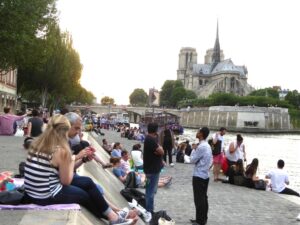
This is also a great location to take a picnic dinner on a warm evening, with goodies bought from one of the local markets and the wonderful patisserie, owned by restaurant La Tour d’Argent, on the corner of Quai de la Tournelle and rue Cardinal Lemoine. You’ll be joining plenty of locals doing the same thing, and it’s all very peaceful and convivial.
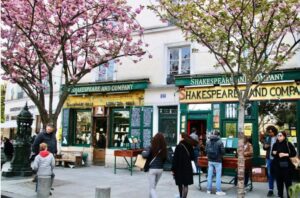
Across the street from Notre Dame is a pretty little park, Square René Viviani, said to have the oldest tree in Paris, a robinia planted in 1601. One side of the park faces onto a small pedestrian street, the rue de la Bucherie, where one of our favourite landmarks, Shakespeare and Company is located. The building was originally a monastery, La Maison du Mustier. It opened as a bookshop called Le Mistral in 1951 by George Whitman who later changed its name to Shakespeare & Co. This change was in honour of a bookseller Whitman admired, Sylvia Beach, who founded the original Shakespeare & Co. in 1919 at 12, rue de l’Odeon, where it was a favourite haunt of the ex-pat intellectuals of the day, such as James Joyce, Gertrude Stein, T. S. Eliot, and Ezra Pound, along with countless of their friends.
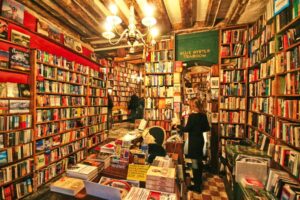
It’s long been one of the city’s most beloved institutions for English speakers. We always pay a visit when we’re in town, and I cannot recall a time when we’ve come away empty-handed. We find books there that we never see anywhere else. The bookshop quickly became a centre for expat writers such as Allen Ginsberg, Anaïs Nin, Henry Miller, Lawence Durrell, James Baldwin and numerous others. This tradition still lives on, with regular talks and readings by writers such as Martin Amis and Alistair Horne among others. The shop has second-hand as well as new books, and next door is a separate antiquarian bookshop, that has many enticing titles you long to take home with you. The bookshop also owns the café on the corner. A visit to the bookshop as early as you can (it opens at 10.00am) is highly recommended, as the crowds outside really build up as the day progresses.
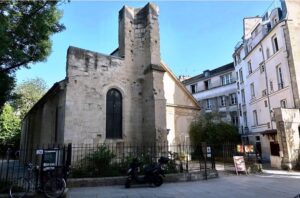
In the small side street that runs along the left-hand side of Shakespeare & Co., rue Saint-Julien-le-Pauvre, are two beautiful little medieval churches. St Julien-le-Pauvre, the oldest church in Paris, was built in the 12th century on the site of a basilica destroyed by the Vikings. This church and its near neighbour, the 13th century Saint Severin, regularly host prestigious concerts by small chamber groups and individual artists at very modest prices. We often go to these and have dinner nearby at one of the many local bistros. The nearby rue Galande is lined with medieval houses At number 42, which houses Studio Garlande, an art-house cinema, you can see a sculpted bas-relief depicting Saint Julian and his wife conveying Christ in a boat. Dating back to the 14th century, it’s one of the oldest in Paris.
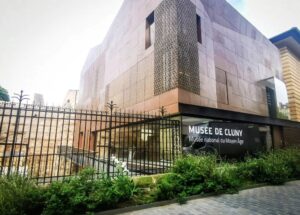
Walking up rue St Jacques to Bvd. St Germain, will take you to the Musée de Cluny. This is the national museum of the Middle Ages, and it stands on the site of Gallo-Roman thermal baths, and are considered amongst the best preserved monumental ancient vestiges in Northern Europe. Within the recently renovated museum you can visit the spectacular frigidarium of the original baths, with its 14 metre high vaults, which now houses artifacts dating as far back as the Romanisation of the city of the Parisii, such as the famous Boatman Pillar from the 1st century. This pillar was offered to the emperor Tiberius by the boatmen of Paris.
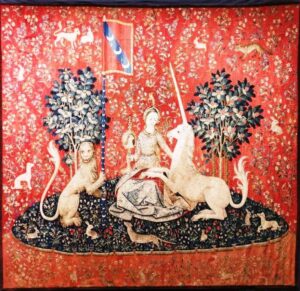
The adjoining Hotel de Cluny was once the medieval residence of the abbots of Cluny Abbey, a jewel of the flamboyant Gothic style. It’s a rare remaining example of civic architecture of medieval Paris, first erected in 1330 and partly rebuilt in the 15th century. The museum houses over 23,000 items of which only about 2,300 are able to be exhibited at any one time. Of these, there are around 1,600 masterpieces of medieval art presented on a chronological basis, that spans more than 1,000 years of history. Among the many jewels of the museum’s collections are the famous tapestries ‘The Lady and the Unicorn’. The medieval-inspired garden adjoining the museum is a pleasant place to take a short break. Before you leave, have a browse through the excellent book and gift shop.
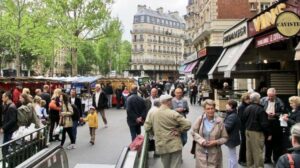
A few minutes’ stroll along Bvd. St Germain will take you to Place Maubert, where metro Maubert Mutualité (Line 10) is located. This square is the site of a lovely outdoor market held 3 mornings a week: Tuesdays, Thursdays and Saturdays. It’s mostly food, but like most other markets, there are a few non-food vendors, two of whom we know well. Tarik is a young Moroccan man who sells the most delectable, flavoured mustards, vinegars and similar products. He has little pots of mustard for around 2 Euros each, which make lovely, easy-to-carry gifts.
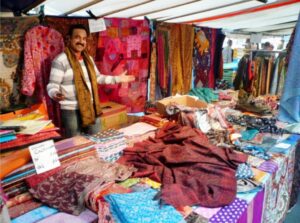
The other vendor we like to visit is Salaria, an Indian man who has the best range of pashminas and scarves we know of, and at prices I can’t beat even in India. Both Tarik and Salaria always greet us warmly, and enjoy having a chat and quick catch-up. They, and a number of other vendors here, also have stalls at the Place Monge market, which is held on the alternate 3 mornings a week to that of Place Maubert.
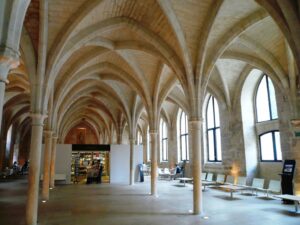
Just near Place Maubert, at 20, rue de Poissy, which runs off Bvd St Germain, is an impressive, large stone medieval building, the Collège des Bernadins. A former Cistercian college of the University of Paris, it was founded by an abbot of Clairvaux and built from 1248. After a massive renovation in 2008, it offers a program of public conferences, symposia, theological studies centre, exhibitions, and concerts. Aside from attending events, the College also runs guided tours every day at 4.00pm.
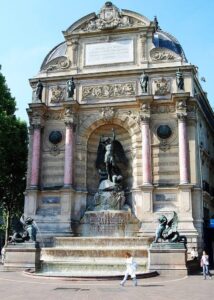
Back at Shakespeare & Co., if you choose to walk up Bvd. Saint-Michel, you will first come to Place Saint-Michel, on the corner of the boulevard and rue Saint-André des Arts. This square is often the scene of improvised music concerts and dance performances. The monumental Saint-Michel fountain features the Archangel Michel (Michael) defeating Evil and is framed by a large triumphal arch and pink marble columns intended to harmonise with the architecture of the buildings surrounding the square. The fountain was built during the reign of Napoleon lll as part of Baron Haussmann’s urban planning, and was constructed in memory of the former Saint-Michel chapel on Ile de la Cité. We tend to avoid the network of little streets off to the left, such as rue de la Harpe and rue de la Huchette, which are full of very ordinary little cafes and restaurants offering “authentic French cuisine”, with people trying to thrust a menu at you as you pass. You can do better almost anywhere else!
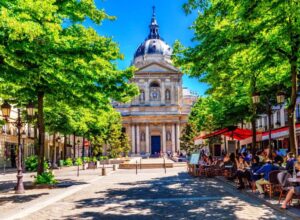
Continuing up Bvd. Saint-Michel, from the tranquil Place de la Sorbonne, on your left you can admire the famous Sorbonne building, commissioned by Cardinal Richelieu in the 17th century and designed by the architect Jacques Lemercier.
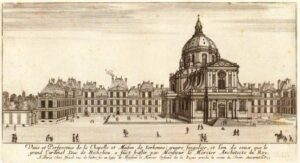
Founded in 1253 by Pierre de Sorbon, chaplain and confessor of King Louis lX, known as Saint-Louis, the Sorbonne was originally a theological college for poor students. It was integrated into the University of Paris, where arts, law and medicine were also taught, and was so prestigious that its name became that of the entire university.

Walking up either Bvd St Michel or rue St Jacques, you will see the imposing dome of the Pantheon in the distance, sitting atop the Montagne Sainte-Geneviève. Resembling a Greek or Roman Temple, it was built between 1758 and 1790 at the behest of King Louis XV, and was intended as a church dedicated to Saint Geneviève, the patron saint of Paris, whose relics were to be housed within it. The architect was Jacques-Germain Soufflot, who had studied classical architecture in Rome, and his design was clearly influenced by the work of Bramante, whom he had studied in Italy. The building is 110m long by 84 m. wide, and 83m high, with a crypt beneath of the same size.
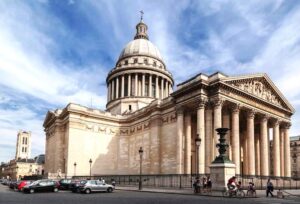
By the time construction was finished, the Revolution had started. The National Constituent Assembly voted in 1791 to transform the church into a mausoleum for the remains of distinguished French citizens, its model being the Pantheon in Rome, which had been used for this purpose since the 17th century. The building was twice restored to church usage during the 19th century, firstly under Napoleon, until the Third Republic finally decreed the building’s exclusive use as a mausoleum in 1881.
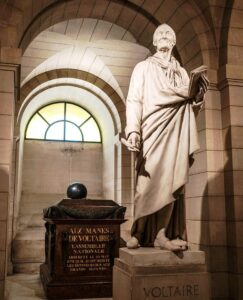
The placement of the remains of Victor Hugo into the crypt in 1885 was its first entombment in over 50 years. From then on, great figures of the nation have been interred in the crypt such as Voltaire, Rousseau, Emile Zola, Alexandre Dumas, Louis Braille, Pierre and Marie Curie, the navigator Louis Antoine de Bougainville, Leon Gambetta, Jean Jaurès, André Malraux, and lately, Josephine Baker, in acknowledgement of her enormous courage as a heroine of the Resistance. She was the first black woman to receive the honour. Step inside to see the murals, and one of the most interesting things there is Foucault’s pendulum suspended from the ceiling that he installed to demonstrate the rotation of the earth. If you have some energy left, climb the stairs to the upper part of the dome. From here you will have a spectacular view of Paris and its landmarks.
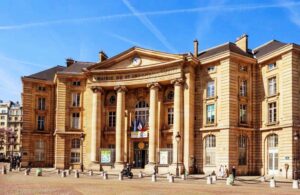
With its grand architectural presence, the Pantheon is the centrepiece of a large open space surrounded by a fascinating group of imposing buildings for the Faculty of Law and the Hotel de Ville of the 5th arrondissement. The spectacular church of Saint-Étienne-du-Mont and the prestigious Henry IV High School with its prominent tower form the backdrop.
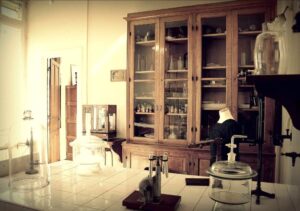
A stone’s throw from the Pantheon is the Curie Museum at no. 1, rue Pierre et Marie Curie. Located in the former laboratory of Marie Curie, the museum retraces the different states of the discoveries of the Curies—a family with five Nobel Prizes—and their enormous scientific achievements. Visitors will have a first-hand glimpse of the equipment they used and objects of memorabilia relating to them. Entry to the museum is free.
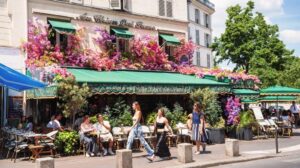
As we’ve seen so far, this neighbourhood is richly endowed with many treasures you’ll wish to see, from some of the city’s greatest monuments, to ancient cobblestone streets, vibrant markets, classic squares and pretty streets. There are any number of cafes and restaurants to rest and enjoy your surroundings before continuing your exploration. There’s simply so much to discover in the Latin Quarter, so I will talk about more of the attractions and sights of this vibrant area in the next blog story. Bonne promenade!
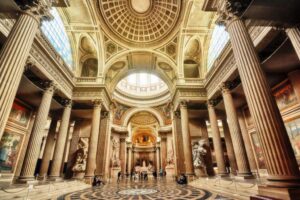


Very interesting. Thank you. I am looking forward to the next installment.
So glad you enjoyed it so far Barbara. There’s such a lot to see in this area, that I’ve really only touched on the main highlights.
Best regards, Cheryl
That was wonderful, Cheryl. Brought back so many memories of when we stayed in your apartment.
Fond regards, Diane
Hi Diane,
Yes, it was something of a trip down memory lane, even for me! In fact, Graham and I are in Nice at the moment, and will be back in Paris in a week or so. As you well know, there’s so much to see and do in the Latin Quarter, which is why I decided to make two stories for the blog rather than a few of the highlights crammed into one. Next blog post will be part 2. We’re so glad the story brought back so many happy memories, and it was lovely to hear from one of our extended “family”! Warmly, Cheryl